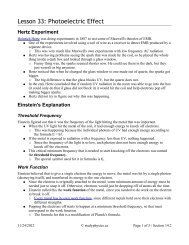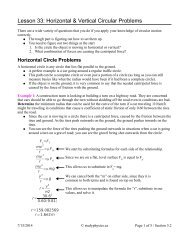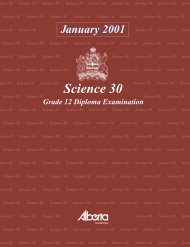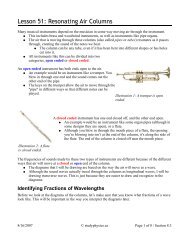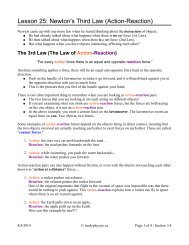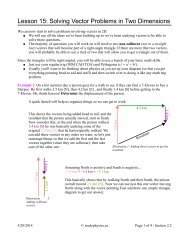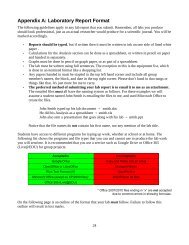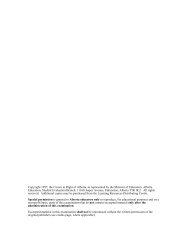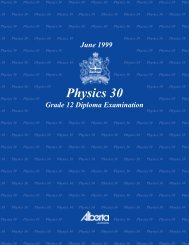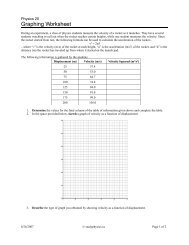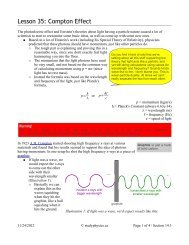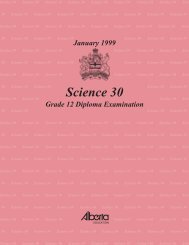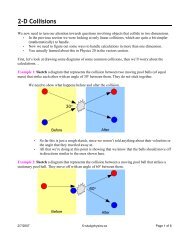Science 30 January 2000 Diploma Examination
Science 30 January 2000 Diploma Examination
Science 30 January 2000 Diploma Examination
Create successful ePaper yourself
Turn your PDF publications into a flip-book with our unique Google optimized e-Paper software.
cience <strong>30</strong> <strong>Science</strong> <strong>30</strong> <strong>Science</strong> <strong>30</strong> <strong>Science</strong> <strong>30</strong> <strong>Science</strong> <strong>30</strong> <strong>Science</strong> <strong>30</strong> <strong>Science</strong> <strong>30</strong> <strong>Science</strong> <strong>30</strong> Scien<br />
cience <strong>30</strong> <strong>Science</strong> <strong>30</strong> <strong>Science</strong> <strong>30</strong> <strong>Science</strong> <strong>30</strong> <strong>Science</strong> <strong>30</strong> <strong>Science</strong> <strong>30</strong> <strong>Science</strong> <strong>30</strong> <strong>Science</strong> <strong>30</strong> Scien<br />
<strong>30</strong> <strong>Science</strong> <strong>30</strong> <strong>Science</strong> <strong>30</strong> <strong>Science</strong> <strong>30</strong> <strong>Science</strong> <strong>30</strong> <strong>Science</strong> <strong>30</strong> <strong>Science</strong> <strong>30</strong> <strong>Science</strong> <strong>30</strong> <strong>Science</strong> <strong>30</strong><br />
cience <strong>30</strong> <strong>Science</strong> <strong>30</strong> <strong>Science</strong> <strong>30</strong> <strong>Science</strong> <strong>30</strong> <strong>Science</strong> <strong>30</strong> <strong>Science</strong> <strong>30</strong> <strong>Science</strong> <strong>30</strong> <strong>Science</strong> <strong>30</strong> Scien<br />
<strong>30</strong> <strong>Science</strong> <strong>30</strong> <strong>Science</strong> <strong>30</strong> <strong>Science</strong> <strong>30</strong> <strong>Science</strong> <strong>30</strong> <strong>Science</strong> <strong>30</strong> <strong>Science</strong> <strong>30</strong> <strong>Science</strong> <strong>30</strong> <strong>Science</strong> <strong>30</strong><br />
<strong>January</strong> <strong>2000</strong><br />
cience <strong>30</strong> <strong>Science</strong> <strong>30</strong> <strong>Science</strong> <strong>30</strong> <strong>Science</strong> <strong>30</strong> <strong>Science</strong> <strong>30</strong> <strong>Science</strong> <strong>30</strong> <strong>Science</strong> <strong>30</strong> <strong>Science</strong> <strong>30</strong> Scien<br />
<strong>30</strong> <strong>Science</strong> <strong>30</strong> <strong>Science</strong> <strong>30</strong> <strong>Science</strong> <strong>30</strong> <strong>Science</strong> <strong>30</strong> <strong>Science</strong> <strong>30</strong> <strong>Science</strong> <strong>30</strong> <strong>Science</strong> <strong>30</strong> <strong>Science</strong> <strong>30</strong><br />
cience <strong>30</strong> <strong>Science</strong> <strong>30</strong> <strong>Science</strong> <strong>30</strong> <strong>Science</strong> <strong>30</strong> <strong>Science</strong> <strong>30</strong> <strong>Science</strong> <strong>30</strong> <strong>Science</strong> <strong>30</strong> <strong>Science</strong> <strong>30</strong> Scien<br />
<strong>30</strong> <strong>Science</strong> <strong>30</strong> <strong>Science</strong> <strong>30</strong> <strong>Science</strong> <strong>30</strong> <strong>Science</strong> <strong>30</strong> <strong>Science</strong> <strong>30</strong> <strong>Science</strong> <strong>30</strong> <strong>Science</strong> <strong>30</strong> <strong>Science</strong> <strong>30</strong><br />
<strong>Science</strong> <strong>30</strong><br />
cience <strong>30</strong> <strong>Science</strong> <strong>30</strong> <strong>Science</strong> <strong>30</strong> <strong>Science</strong> <strong>30</strong> <strong>Science</strong> <strong>30</strong> <strong>Science</strong> <strong>30</strong> <strong>Science</strong> <strong>30</strong> <strong>Science</strong> <strong>30</strong> Scien<br />
Grade 12 <strong>Diploma</strong> <strong>Examination</strong><br />
<strong>30</strong> <strong>Science</strong> <strong>30</strong> <strong>Science</strong> <strong>30</strong> <strong>Science</strong> <strong>30</strong> <strong>Science</strong> <strong>30</strong> <strong>Science</strong> <strong>30</strong> <strong>Science</strong> <strong>30</strong> <strong>Science</strong> <strong>30</strong> <strong>Science</strong> <strong>30</strong><br />
cience <strong>30</strong> <strong>Science</strong> <strong>30</strong> <strong>Science</strong> <strong>30</strong> <strong>Science</strong> <strong>30</strong> <strong>Science</strong> <strong>30</strong> <strong>Science</strong> <strong>30</strong> <strong>Science</strong> <strong>30</strong> <strong>Science</strong> <strong>30</strong> Scien<br />
<strong>30</strong> <strong>Science</strong> <strong>30</strong> <strong>Science</strong> <strong>30</strong> <strong>Science</strong> <strong>30</strong> <strong>Science</strong> <strong>30</strong> <strong>Science</strong> <strong>30</strong> <strong>Science</strong> <strong>30</strong> <strong>Science</strong> <strong>30</strong> <strong>Science</strong> <strong>30</strong><br />
cience <strong>30</strong> <strong>Science</strong> <strong>30</strong> <strong>Science</strong> <strong>30</strong> <strong>Science</strong> <strong>30</strong> <strong>Science</strong> <strong>30</strong> <strong>Science</strong> <strong>30</strong> <strong>Science</strong> <strong>30</strong> <strong>Science</strong> <strong>30</strong> Scien<br />
<strong>30</strong> <strong>Science</strong> <strong>30</strong> <strong>Science</strong> <strong>30</strong> <strong>Science</strong> <strong>30</strong> <strong>Science</strong> <strong>30</strong> <strong>Science</strong> <strong>30</strong> <strong>Science</strong> <strong>30</strong> <strong>Science</strong> <strong>30</strong> <strong>Science</strong> <strong>30</strong><br />
cience <strong>30</strong> <strong>Science</strong> <strong>30</strong> <strong>Science</strong> <strong>30</strong> <strong>Science</strong> <strong>30</strong> <strong>Science</strong> <strong>30</strong> <strong>Science</strong> <strong>30</strong> <strong>Science</strong> <strong>30</strong> <strong>Science</strong> <strong>30</strong> Scien<br />
<strong>30</strong> <strong>Science</strong> <strong>30</strong> <strong>Science</strong> <strong>30</strong> <strong>Science</strong> <strong>30</strong> <strong>Science</strong> <strong>30</strong> <strong>Science</strong> <strong>30</strong> <strong>Science</strong> <strong>30</strong> <strong>Science</strong> <strong>30</strong> <strong>Science</strong> <strong>30</strong><br />
cience <strong>30</strong> <strong>Science</strong> <strong>30</strong> <strong>Science</strong> <strong>30</strong> <strong>Science</strong> <strong>30</strong> <strong>Science</strong> <strong>30</strong> <strong>Science</strong> <strong>30</strong> <strong>Science</strong> <strong>30</strong> <strong>Science</strong> <strong>30</strong> Scien<br />
<strong>30</strong> <strong>Science</strong> <strong>30</strong> <strong>Science</strong> <strong>30</strong> <strong>Science</strong> <strong>30</strong> <strong>Science</strong> <strong>30</strong> <strong>Science</strong> <strong>30</strong> <strong>Science</strong> <strong>30</strong> <strong>Science</strong> <strong>30</strong> <strong>Science</strong> <strong>30</strong><br />
cience <strong>30</strong> <strong>Science</strong> <strong>30</strong> <strong>Science</strong> <strong>30</strong> <strong>Science</strong> <strong>30</strong> <strong>Science</strong> <strong>30</strong> <strong>Science</strong> <strong>30</strong> <strong>Science</strong> <strong>30</strong> <strong>Science</strong> <strong>30</strong> Scien<br />
i<br />
<strong>30</strong> <strong>Science</strong> <strong>30</strong> <strong>Science</strong> <strong>30</strong> <strong>Science</strong> <strong>30</strong> <strong>Science</strong> <strong>30</strong> <strong>Science</strong> <strong>30</strong> <strong>Science</strong> <strong>30</strong> <strong>Science</strong> <strong>30</strong> <strong>Science</strong> <strong>30</strong>
<strong>January</strong> <strong>2000</strong><br />
<strong>Science</strong> <strong>30</strong><br />
Grade 12 <strong>Diploma</strong> <strong>Examination</strong><br />
Description<br />
Time: This examination was developed<br />
to be completed in 2.5 h; however, you<br />
may take an additional 0.5 h to complete<br />
the examination.<br />
This is a closed-book examination<br />
consisting of<br />
• 40 multiple-choice and 12 numericalresponse<br />
questions of equal value,<br />
worth 65% of the examination<br />
• 1 short-answer question and 2 longanswer<br />
questions, worth 35% of the<br />
examination.<br />
This examination contains sets<br />
of related questions.<br />
A set of questions may contain<br />
multiple-choice and/or numericalresponse<br />
and/or written-response<br />
questions.<br />
A science data booklet is provided for<br />
your reference.<br />
Note: The perforated pages at the back of<br />
this booklet may be torn out and used for<br />
your rough work. No marks will be given<br />
for work done on the tear-out pages.<br />
Instructions<br />
• You are expected to provide your own<br />
scientific calculator.<br />
• Use only an HB pencil for the<br />
machine-scored answer sheet.<br />
• Fill in the information required on the<br />
answer sheet and the examination<br />
booklet as directed by the presiding<br />
examiner.<br />
• Read each question carefully.<br />
• Consider all numbers used in the<br />
examination to be the result of a<br />
measurement or observation.<br />
• When performing calculations, use the<br />
values of the constants provided in the<br />
data booklet. Do not use the values<br />
programmed in your calculator.<br />
• If you wish to change an answer, erase<br />
all traces of your first answer.<br />
• Do not fold the answer sheet.<br />
• The presiding examiner will collect<br />
your answer sheet and examination<br />
booklet and send them to Alberta<br />
Learning.<br />
• Now turn this page and read the<br />
detailed instructions for answering<br />
machine-scored and written-response<br />
questions.
Multiple Choice<br />
• Decide which of the choices best<br />
completes the statement or answers<br />
the question.<br />
• Locate that question number on the<br />
separate answer sheet provided and<br />
fill in the circle that corresponds to<br />
your choice.<br />
Example<br />
This examination is for the subject of<br />
A. science<br />
B. biology<br />
C. physics<br />
D. chemistry<br />
Answer Sheet<br />
A B C D<br />
Numerical Response<br />
• Record your answer on the answer<br />
sheet provided by writing it in the<br />
boxes and then filling in the<br />
corresponding circles.<br />
• If an answer is a value between 0 and 1<br />
(e.g., 0.25), then be sure to record the 0<br />
before the decimal place.<br />
• Enter the first digit of your answer<br />
in the left-hand box and leave any<br />
unused boxes blank.<br />
Examples<br />
Calculation Question and Solution<br />
The average of the values 21.0, 25.5, and<br />
24.5 is _________.<br />
(Record your answer to three digits in the<br />
numerical-response section on the answer<br />
sheet.)<br />
Average = (21.0 + 25.5 + 24.5)/3<br />
= 23.666<br />
= 23.7 (rounded to three digits)<br />
Record 23.7 on the<br />
answer sheet 2 3 . 7<br />
. .<br />
0 0 0 0<br />
1 1 1 1<br />
2 2 2 2<br />
3 3 3 3<br />
4 4 4 4<br />
5 5 5 5<br />
6 6 6 6<br />
7 7 7 7<br />
8 8 8 8<br />
9 9 9 9<br />
ii
Written Response<br />
Correct-Order Question and Solution<br />
When the following subjects are arranged in<br />
alphabetical order, the order is ____, ____,<br />
____, and ____ .<br />
1 physics<br />
2 biology<br />
3 science<br />
4 chemistry<br />
(Record all four digits of your answer in the<br />
numerical-response section on the answer<br />
sheet.)<br />
Answer: 2413<br />
Record 2413 on the<br />
answer sheet<br />
2 4 1 3<br />
. .<br />
0 0 0 0<br />
1 1 1 1<br />
2 2 2 2<br />
3 3 3 3<br />
4 4 4 4<br />
5 5 5 5<br />
6 6 6 6<br />
7 7 7 7<br />
8 8 8 8<br />
9 9 9 9<br />
• Write your answers in the examination<br />
booklet as neatly as possible.<br />
• For full marks, your answers must<br />
address all aspects of the question.<br />
• Descriptions and/or explanations of<br />
concepts must be correct and include<br />
pertinent ideas, diagrams, calculations,<br />
and formulas.<br />
• Your answers must be presented in a<br />
well-organized manner using complete<br />
sentences, correct units, and significant<br />
digits where appropriate.<br />
• Relevant scientific, technological, and/or<br />
societal concepts and examples must be<br />
identified and made explicit.<br />
iii
Personnel in a medical clinic must understand body systems and have knowledge<br />
of drugs and chemistry.<br />
1. Treatment in a low-air-pressure chamber causes a person’s body to produce more<br />
oxygen-carrying blood cells, which are called<br />
A. platelets<br />
B. helper T cells<br />
C. red blood cells<br />
D. white blood cells<br />
2. Rapid multiplication of bacterial cells in a person’s body could be the result of an<br />
insufficient number of<br />
A. antigens<br />
B. platelets<br />
C. red blood cells<br />
D. white blood cells<br />
3. The skin on the back of a patient’s hand must be cleaned thoroughly before an<br />
intravenous needle is inserted into it because inserting the needle<br />
A. stimulates B cells to produce antibodies<br />
B. immunizes the patient against disease-causing organisms that live on the skin<br />
C. stimulates the sensory receptors in the back of the hand, which send a pain signal<br />
to the brain<br />
D. produces a break in the skin, which can let disease-causing organisms into the<br />
patient’s hand<br />
1
4. Which of the following diagrams represents the passage of blood through the body,<br />
heart, and lungs<br />
A. B.<br />
Lungs<br />
Body<br />
Body<br />
Lungs<br />
C. D.<br />
Lungs<br />
Lungs<br />
Body<br />
Body<br />
5. A blood vessel is classified as an artery if it carries<br />
A. oxygenated blood<br />
B. deoxygenated blood<br />
C. blood toward the heart<br />
D. blood away from the heart<br />
2
–<br />
–<br />
Use the following information to answer the next question.<br />
Four Substances Transported by Blood<br />
1 Carbon dioxide<br />
2 Dissolved waste<br />
3 Glucose<br />
4 Oxygen<br />
Numerical Response<br />
1. Match the substances transported by blood, as numbered above, with the appropriate<br />
descriptions given below. Use each number only once.<br />
Is an organic nutrient ______ (Record in the first column.)<br />
Is removed in lungs ______ (Record in the second column.)<br />
Is removed in kidneys ______ (Record in the third column.)<br />
Is required for respiration ______ (Record in the fourth column.)<br />
(Record your answer in the numerical-response section on the answer sheet.)<br />
____________________<br />
6. The pain reliever salicylic acid is a carboxylic acid whose organic functional group is<br />
A.<br />
O<br />
=<br />
R–C –<br />
OH<br />
B.<br />
H<br />
–<br />
O<br />
=<br />
R–C–O–C–R<br />
H<br />
C.<br />
H<br />
–<br />
R–C–R<br />
OH<br />
D.<br />
=<br />
R–C –<br />
O<br />
H<br />
3
7. Because salicylic acid is a weak acid, when mixed with water, its properties include a<br />
A. low degree of dissociation in water and a pH of less than 7<br />
B. high degree of dissociation in water and a pH of less than 7<br />
C. low degree of dissociation in water and a pH of greater than 7<br />
D. high degree of dissociation in water and a pH of greater than 7<br />
8. Salicylic acid may be used to form a buffer. The action of a buffer<br />
A. increases pH when a base is added to it<br />
B. decreases pH when an acid is added to it<br />
C. maintains a constant pH when an acid or a base is added to it<br />
D. causes large changes in pH when an acid or base is added to it<br />
4
The exploration of space adds to our knowledge of the universe and has produced<br />
a number of theories about it.<br />
9. According to the steady state theory and the big bang theory, the universe is<br />
expanding. Evidence supporting the theory of an expanding universe is that the<br />
electromagnetic radiation collected from distant galaxies<br />
A. undergoes red shift<br />
B. undergoes blue shift<br />
C. is emitted in a wide range of frequencies<br />
D. is emitted in a narrow range of frequencies<br />
10. In a recent space shuttle experiment, power was produced by pulling a very long<br />
conducting wire behind the shuttle through Earth’s magnetic field. The<br />
phenomenon that was being studied likely involved the<br />
A. creation of a magnetic field through induction<br />
B. interaction of electrical and gravitational fields<br />
C. interaction of magnetic and gravitational fields<br />
D. creation of an electrical current through induction<br />
11. Objects sent into orbit around Earth are known as artificial satellites. Natural<br />
satellites orbiting around planets are known as<br />
A. moons<br />
B. galaxies<br />
C. constellations<br />
D. solar systems<br />
5
12. Certain types of radio waves are used for communicating with spacecraft. Radio<br />
signals may be modified through amplitude modulation (AM) or through frequency<br />
modulation (FM). Which of the following diagrams represents a radio signal with a<br />
changing frequency<br />
A.<br />
B.<br />
C.<br />
D.<br />
Numerical Response<br />
2. Mars has a mass of 6.42 × 10 23 kg. When a probe orbiting Mars is 3.52 × 10 6 m<br />
from the centre of the planet, the gravitational field strength of Mars acting upon the<br />
probe is _________N/kg.<br />
(Record your answer to three digits in the numerical-response section on the answer sheet.)<br />
6
Use the following information to answer the next question.<br />
Field Graph<br />
Strength of field<br />
Distance<br />
Short Answer – 5%<br />
Electrical and gravitational fields have many properties in common. One such<br />
property is that the strength of these fields varies with distance. On the grid above,<br />
sketch the line that demonstrates the relationship between the strength of a field and<br />
distance, and, in a few sentences, describe this relationship.<br />
.....................................................................................................................................................<br />
.....................................................................................................................................................<br />
.....................................................................................................................................................<br />
.....................................................................................................................................................<br />
.....................................................................................................................................................<br />
.....................................................................................................................................................<br />
7
13. The composition of Mars’ atmosphere has been determined through spectroscopic<br />
analysis. The visible spectrum of Mars contains narrow, dark lines caused by<br />
A. refraction of light in space<br />
B. diffraction of light between Mars and Earth<br />
C. dispersion of electromagnetic radiation by Earth’s magnetic field<br />
D. gases in Mars’ atmosphere absorbing certain electromagnetic radiation<br />
Use the following information to answer the next question.<br />
Atmospheric Composition of Planets<br />
Venus Earth Mars<br />
Nitrogen 3% 77% 3%<br />
Oxygen almost zero 21% almost zero<br />
Carbon dioxide 97% almost zero 95%<br />
Other gases almost zero 2% 2%<br />
Relative atmospheric pressure 90 1 0.01<br />
14. Compared with Mars and Venus, Earth’s atmosphere contains a very small amount<br />
of carbon dioxide. This is likely because<br />
A. most of Earth’s carbon dioxide is dissolved in polar ice<br />
B. green plants on Earth consume carbon dioxide and produce oxygen<br />
C. Earth’s weak gravitational force allows carbon dioxide to escape into space<br />
D. Earth’s proximity to the sun heats the atmosphere enough to decompose the<br />
carbon dioxide<br />
15. Since astronauts in space are exposed to increased radiation, they may have an<br />
increased incidence of genetic mutations. A genetic mutation can be defined as<br />
A. non-disjunction during meiosis<br />
B. a change in the base sequence of DNA<br />
C. a change in the number of chromosomes in a gamete<br />
D. the failure of sugar-phosphate bonds to form in DNA<br />
8
Use the following information to answer the next question.<br />
One strand of a small segment of DNA has the sequence<br />
A - A - T - C - T - C - G - T - A<br />
16. The sequence of the complementary strand is<br />
A. G - G - C - T - C - T - A - C - G<br />
B. T - T - A - G - A - G - C - A - T<br />
C. C - C - G - A - G - A - T - G - C<br />
D. A - A - T - C - T - C - G - T - A<br />
____________________<br />
Numerical Response<br />
3. One type of damaging radiation that may be a hazard in space has a wavelength<br />
of 5.10 × 10 –13 m. The frequency of this radiation is ______× 10 20 Hz.<br />
(Record your answer to three digits in the numerical-response section on the answer sheet.)<br />
9
A scientific expedition travelled to the Arctic to study environmental issues.<br />
17. Before leaving, expedition members were vaccinated. A number of specific<br />
vaccines were required because bacteria and viruses differ in<br />
A. size<br />
B. their immunity<br />
C. the antigens they contain<br />
D. the antibodies they contain<br />
18. One of the vaccinations that expedition members received was to protect them<br />
against the flu. They will need to continue getting new vaccinations each flu season<br />
because<br />
A. the vaccines break down very quickly<br />
B. these viruses readily produce different strains<br />
C. the body filters the vaccines out of the body in a short time<br />
D. memory T cells attack the vaccines and destroy the protective properties<br />
19. As they left their airplane, expedition members experienced a sharp glare of<br />
sunlight reflecting off the Arctic ice. The reflected glare can be reduced by<br />
wearing protective glasses with a<br />
A. convex lens<br />
B. concave lens<br />
C. polarizing filter<br />
D. magnifying glass<br />
10
Use the following information to answer the next question.<br />
A reflex arc dictates the eyes’ response to bright light.<br />
Structures in Reflex Arc<br />
1 interneuron<br />
2 effector<br />
3 sensory neuron<br />
4 motor neuron<br />
Numerical Response<br />
4. When the eye responds to a bright flash of light, electrical impulses move through<br />
the structures of the reflex arc in the sequence _____, _____, _____, _____.<br />
(Record your four-digit answer in the numerical-response section on the answer sheet.)<br />
Use the following information to answer the next question.<br />
Diagram of the Human Eye<br />
Light<br />
rays<br />
1<br />
2<br />
3<br />
4<br />
Numerical Response<br />
5. Match each of the structures of the eye numbered above with its appropriate named below.<br />
Retina ______ (Record in the first column.)<br />
Iris ______ (Record in the second column.)<br />
Cornea ______ (Record in the third column.)<br />
Lens ______ (Record in the fourth column.)<br />
(Record your answer in the numerical-response section on the answer sheet.)<br />
11
20. Expedition members titrated a 10.0 mL sample of rain water with a 1.00 × 10 –3 mol/L<br />
sodium hydroxide solution. The volume of sodium hydroxide required for their<br />
titration was 1.75 mL. The hydronium ion concentration, [H 3 O + (aq)], in the<br />
sample was<br />
A. 1.75 × 10 –4 mol/L<br />
B. 1.75 mol/L<br />
C. 5.71 × 10 –4 mol/L<br />
D. 5.71 mol/L<br />
21. The expedition members found that the pH of rain water in an area decreased from<br />
7 to 5 over a period of time. This meant that the hydronium ion concentration,<br />
[H 3 O + (aq)], of the rainwater had<br />
A. increased by a factor of 2<br />
B. decreased by a factor of 2<br />
C. increased by a factor of 100<br />
D. decreased by a factor of 100<br />
22. Expedition members added a sample of rainwater that had a pH of 4.7 to a mixture<br />
of the indicators thymol blue, phenolphthalein, and alizarin yellow R. The colour<br />
of the resulting solution was<br />
A. green<br />
B. brown<br />
C. yellow<br />
D. orange<br />
12
Numerical Response<br />
6. The pH of a water sample that has a hydronium ion concentration, [H 3 O + (aq)], of<br />
3.0 × 10 –5 mol/L is ______.<br />
(Record your answer to three digits in the numerical-response section on the answer sheet.)<br />
Use the following information to answer the next question.<br />
Some Pollutants<br />
1 Dioxins and furans<br />
2 Phosphates<br />
3 NO x gases<br />
4 Lead<br />
Numerical Response<br />
7. Some pollutants accumulate in the Arctic. Match each of the pollutants numbered<br />
above with the appropriate source given below. Use each number only once.<br />
Fertilizers ______ (Record in the first column.)<br />
Batteries ______ (Record in the second column.)<br />
Automobiles ______ (Record in the third column.)<br />
Pesticides ______ (Record in the fourth column.)<br />
(Record your answer in the numerical-response section on the answer sheet.)<br />
23. The two main contributors to the formation of acid rain are<br />
A. methane and ozone<br />
B. ozone and nitrogen oxides<br />
C. sulphur oxides and methane<br />
D. nitrogen oxides and sulphur oxides<br />
13
Use the following information to answer the next question.<br />
Some Effects of Atmospheric Pollutants<br />
I<br />
II<br />
III<br />
IV<br />
V<br />
Corrosion of metal surfaces<br />
Destruction of the ozone layer<br />
Deterioration of building materials<br />
Death of vegetation<br />
Global warming<br />
24. Which of the effects listed above are caused by acidic deposition<br />
A. Effects I, II, and IV<br />
B. Effects I, III, and IV<br />
C. Effects II, III, and V<br />
D. Effects II, IV, and V<br />
____________________<br />
25. Suspended particles were among the pollutants studied by the expedition. In the<br />
atmosphere, suspended particles can contribute to lower global temperatures by<br />
A. reflecting incoming electromagnetic radiation into space<br />
B. refracting incoming electromagnetic radiation into space<br />
C. polarizing incoming electromagnetic radiation, thereby increasing the amount<br />
of energy Earth receives<br />
D. filtering high-energy electromagnetic radiation, thereby increasing the amount<br />
of energy Earth receives<br />
14
The expedition boarded a small submarine to continue their exploration<br />
of the Arctic.<br />
Use the following information to answer the next question.<br />
An Electrical Circuit Aboard the Submarine<br />
I II III<br />
IV<br />
Navigation instrument<br />
Fuse<br />
Power source<br />
26. An expedition member investigated the submarine’s electrical circuit because none of<br />
the navigational instruments worked. He found that one of the fuses was burned out.<br />
The burned out fuse is labelled<br />
A. I<br />
B. II<br />
C. III<br />
D. IV<br />
27. A diode is a device in an electric circuit. It permits electrons to travel in only one<br />
direction. A structure in the circulatory system that has a similar function to that of<br />
a diode in an electronic circuit is a<br />
A. vein<br />
B. valve<br />
C. artery<br />
D. capillary<br />
15
Use the following information to answer the next three questions.<br />
Circuit for Trilight Lamp<br />
120 Ω<br />
Switch I<br />
240 Ω<br />
Switch II<br />
110 V<br />
The control switch on a trilight lamp can control three different light<br />
intensities (high, medium, and low), depending on the combination of<br />
switches activated.<br />
28. When switches I and II are closed, the total resistance in the above circuit is<br />
A. 0.0125 Ω<br />
B. 3.00 Ω<br />
C. 80.0 Ω<br />
D. 360 Ω<br />
29. The switch combination that will draw the largest current is<br />
A. I open, II open<br />
B. I open, II closed<br />
C. I closed, II open<br />
D. I closed, II closed<br />
16
<strong>30</strong>. As current passes through a light filament, the temperature of the filament<br />
increases and its colour changes from<br />
A. red to yellow to white<br />
B. red to white to yellow<br />
C. white to yellow to red<br />
D. yellow to white to red<br />
31. A nuclear-powered submarine is most likely fueled by<br />
A. ethanol<br />
B. uranium<br />
C. methane<br />
D. hydrogen<br />
32. A nuclear reactor produces high-voltage electrical energy that must be stepped<br />
down for use in a submarine. To decrease the voltage in the submarine’s circuits,<br />
the engineers would use<br />
A. a resistor<br />
B. a generator<br />
C. an alternator<br />
D. a transformer<br />
Numerical Response<br />
8. An 18.0 A welder is used for maintenance aboard the submarine. When plugged<br />
into a 220 V circuit, the resistance of the welder is ______Ω.<br />
(Record your answer to three digits in the numerical-response section on the answer sheet.)<br />
17
The production and use of energy is one of the foremost concerns in attempts to<br />
achieve sustainable development.<br />
Use the following information to answer the next question.<br />
Four Energy Transformations<br />
1 Matter is converted to energy in a fission reactor.<br />
2 Water releases energy as it turns to ice.<br />
3 Gasoline burns at high temperatures in a car engine.<br />
4 During a fusion reaction, He<br />
2 3 is formed.<br />
Numerical Response<br />
9. These energy transformations, ranked from least to greatest amount of energy<br />
released per gram of reactants used, are _____, _____, _____, and _____.<br />
least greatest<br />
(Record your four-digit answer in the numerical-response section on the answer sheet.)<br />
18
Use the following information to answer the next four questions.<br />
CANDU Reactor<br />
Reactor Building<br />
1 Steam<br />
Turbine Building<br />
Coolent<br />
(heavy water)<br />
Steam<br />
2 Turbine<br />
4 Generator<br />
Calandria<br />
3 Fuel<br />
bundles<br />
Moderator<br />
(heavy<br />
water)<br />
Control rods<br />
Circulating<br />
water<br />
Ordinary<br />
water<br />
5 Cooling<br />
water<br />
Numerical Response<br />
10. The order of energy conversions in the above reactor, listed from the first conversion<br />
until useable energy leaves the reactor, is _____, _____, _____, and _____.<br />
(Record your four-digit answer in the numerical-response section on the answer sheet.)<br />
19
33. The alpha decay of radium-226 is represented by<br />
A. 226<br />
Ra →<br />
222<br />
Rn + He<br />
2 4<br />
88<br />
86<br />
B. 226<br />
Ra →<br />
222<br />
Rn +<br />
4 4 He<br />
88<br />
84<br />
C. 226<br />
Rd →<br />
222<br />
Po +<br />
4 4 He<br />
88<br />
84<br />
D. 226<br />
Rd →<br />
222<br />
Po +<br />
2 4 He<br />
88<br />
84<br />
Numerical Response<br />
11. The energy produced when 0.220 kg of nuclear fuel is transformed completely<br />
into energy is __________ × 10 16 J.<br />
(Record your answer to three digits in the numerical-response section on the answer sheet.)<br />
34. An environmental concern that may be associated with coal but not with nuclear<br />
power generation is<br />
A. acidic deposition<br />
B. thermal pollution<br />
C. pollution from phosphates<br />
D. depletion of the ozone layer<br />
20
Use the following information to answer the next question.<br />
Conventional Power Plant<br />
35%<br />
Electrical<br />
power<br />
Fuel in<br />
100%<br />
Conventional<br />
power plant<br />
Waste<br />
heat<br />
65%<br />
Numerical Response<br />
12. The efficiency of the conventional power plant is _______%.<br />
(Record your answer to two digits in the numerical-response section on the answer sheet.)<br />
21
Use the following information to answer the next question.<br />
Geothermal Power Station<br />
This simplified diagram represents a geothermal power station. Pumps<br />
drive cold water to the hot rocks, where it is heated, and steam is returned to<br />
the surface.<br />
Power<br />
station<br />
Steam<br />
(180°C)<br />
Cold<br />
water<br />
(20°C)<br />
Rocks<br />
shattered<br />
by explosives<br />
(250°C)<br />
Water is forced<br />
through the hot<br />
shattered rocks<br />
35. The steam that returns to the power station at a temperature of 180°C is used to<br />
A. turn a motor to produce electricity<br />
B. turn a generator to produce electricity<br />
C. transform solar energy into electric energy<br />
D. transform chemical energy into electric energy<br />
22
Use the following information to answer the next question.<br />
Combustion of Octane<br />
C 8 H 18(l) + 2 25 O 2(g) → 8 CO 2(g) + 9 H 2 O (g)<br />
36. Octane, (C 8 H 18(l) ), may be used as a fuel in small generators. For each mole of<br />
octane burned, the amount of energy released is<br />
A. 250.0 kJ<br />
B. 385.3 kJ<br />
C. 885.3 kJ<br />
D. 5074.2 kJ<br />
23
Scientists continue their efforts to develop effective pesticides that are<br />
environmentally friendly.<br />
Use the following information to answer the next two questions.<br />
The larvae of leaf-folder moths feed on the leaves of young rice plants. In a<br />
particular area, Asian farmers controlled leaf damage by spraying the rice<br />
plants with methylparathion. In order to determine if spraying the<br />
insecticide had an effect on the yield of rice, researchers sprayed only half<br />
the plants in each field. They found that plants that lost leaves to the larvae<br />
produced the same yield of rice as the sprayed plants. After two seasons<br />
without spraying, the population of many types of insects, including the<br />
crickets and beetles that feed on the larvae, increased significantly. Larger<br />
predators such as frogs and fish also increased in number.<br />
37. In this test, the manipulated variable and responding variable were, respectively,<br />
A. leaf-folder larvae and yield of rice<br />
B. yield of rice and application of insecticide<br />
C. application of insecticide and yield of rice<br />
D. leaf-folder larvae and application of insecticide<br />
38. Although not conclusive, the observations made by the researchers indicate that the<br />
spraying program may be<br />
A. unnecessary<br />
B. cost-effective<br />
C. target-specific<br />
D. environmentally friendly<br />
24
39. The pesticide methylparathion is a cholinesterase inhibitor. The role of<br />
cholinesterase is to<br />
A. absorb acetylcholine<br />
B. release acetylcholine<br />
C. break down acetylcholine<br />
D. manufacture acetylcholine<br />
Use the following information to answer the next question.<br />
A Neuron<br />
I<br />
II<br />
III<br />
IV<br />
40. Acetylcholine is produced at the part of the neuron labelled<br />
A. I<br />
B. II<br />
C. III<br />
D. IV<br />
The written-response questions follow on the next page.<br />
25
Use the following information to answer the next question.<br />
The caterpillar of the diamondback moth is controlled by treating it with an<br />
insecticide called Bt. A caterpillar population in an area treated with Bt is<br />
becoming resistant to Bt.<br />
You are given 10 male diamondback moths and 10 unfertilized female<br />
diamondback moths from an area that has never been treated with Bt<br />
insecticide and another group of 10 male diamondback moths and 10<br />
unfertilized female diamondback moths from a population that has developed<br />
resistance to Bt.<br />
Long Answer – 15%<br />
1. a. Describe an experiment that you could carry out to determine whether or not the<br />
resistance is due to a recessive allele (a) or a dominant allele (A). Describe the<br />
results you would expect if the resistance trait is recessive and the results you<br />
would expect if the resistance trait is dominant. Use diagrams, tables, or Punnett<br />
squares to clarify your answer.<br />
.......................................................................................................................................................<br />
.......................................................................................................................................................<br />
.......................................................................................................................................................<br />
.......................................................................................................................................................<br />
.......................................................................................................................................................<br />
.......................................................................................................................................................<br />
.......................................................................................................................................................<br />
.......................................................................................................................................................<br />
.......................................................................................................................................................<br />
.......................................................................................................................................................<br />
.......................................................................................................................................................<br />
.......................................................................................................................................................<br />
.......................................................................................................................................................<br />
.......................................................................................................................................................<br />
.......................................................................................................................................................<br />
.......................................................................................................................................................<br />
26
.......................................................................................................................................................<br />
.......................................................................................................................................................<br />
.......................................................................................................................................................<br />
.......................................................................................................................................................<br />
.......................................................................................................................................................<br />
.......................................................................................................................................................<br />
.......................................................................................................................................................<br />
.......................................................................................................................................................<br />
.......................................................................................................................................................<br />
.......................................................................................................................................................<br />
b. If an insecticide must be used, describe desirable characteristics that it should have.<br />
.......................................................................................................................................................<br />
.......................................................................................................................................................<br />
.......................................................................................................................................................<br />
.......................................................................................................................................................<br />
.......................................................................................................................................................<br />
.......................................................................................................................................................<br />
.......................................................................................................................................................<br />
.......................................................................................................................................................<br />
.......................................................................................................................................................<br />
.......................................................................................................................................................<br />
.......................................................................................................................................................<br />
.......................................................................................................................................................<br />
.......................................................................................................................................................<br />
.......................................................................................................................................................<br />
.......................................................................................................................................................<br />
.......................................................................................................................................................<br />
Turn the page to begin the next question.<br />
27
Use the following information to answer the next question.<br />
Electrical energy can be generated in power stations from a number of<br />
different sources, such as<br />
1. nuclear (fission) power<br />
2. wind power<br />
3. tidal power<br />
4. hydroelectric power<br />
Long Answer – 15%<br />
2. Select one of the sources listed above and explain how electrical energy is produced.<br />
Start with the origin of the energy source you have chosen and continue your<br />
explanation to the point where electrical energy is produced. Include all energy<br />
transformations. Describe the advantages and disadvantages of generating electricity<br />
from this source.<br />
.......................................................................................................................................................<br />
.......................................................................................................................................................<br />
.......................................................................................................................................................<br />
.......................................................................................................................................................<br />
.......................................................................................................................................................<br />
.......................................................................................................................................................<br />
.......................................................................................................................................................<br />
.......................................................................................................................................................<br />
.......................................................................................................................................................<br />
.......................................................................................................................................................<br />
.......................................................................................................................................................<br />
.......................................................................................................................................................<br />
.......................................................................................................................................................<br />
.......................................................................................................................................................<br />
.......................................................................................................................................................<br />
.......................................................................................................................................................<br />
.......................................................................................................................................................<br />
.......................................................................................................................................................<br />
28
.......................................................................................................................................................<br />
.......................................................................................................................................................<br />
.......................................................................................................................................................<br />
.......................................................................................................................................................<br />
.......................................................................................................................................................<br />
.......................................................................................................................................................<br />
.......................................................................................................................................................<br />
.......................................................................................................................................................<br />
.......................................................................................................................................................<br />
.......................................................................................................................................................<br />
.......................................................................................................................................................<br />
.......................................................................................................................................................<br />
.......................................................................................................................................................<br />
.......................................................................................................................................................<br />
.......................................................................................................................................................<br />
.......................................................................................................................................................<br />
.......................................................................................................................................................<br />
.......................................................................................................................................................<br />
.......................................................................................................................................................<br />
.......................................................................................................................................................<br />
.......................................................................................................................................................<br />
.......................................................................................................................................................<br />
.......................................................................................................................................................<br />
.......................................................................................................................................................<br />
.......................................................................................................................................................<br />
.......................................................................................................................................................<br />
.......................................................................................................................................................<br />
You have now completed the examination.<br />
If you have time, you may wish to check your answers.<br />
29
Tear-out<br />
Page<br />
No marks will be given for work done on this page.<br />
Fold and tear along perforation.
<strong>Science</strong> <strong>30</strong> <strong>January</strong> <strong>2000</strong><br />
Keys<br />
Sample Answers<br />
Scoring Guides<br />
Multiple-Choice<br />
1. C 21. C<br />
2. D 22. C<br />
3. D 23. D<br />
4. C 24. B<br />
5. D 25. A<br />
6. A 26. A<br />
7. A 27. B<br />
8. C 28. C<br />
9. A 29. D<br />
10. D <strong>30</strong>. A<br />
11. A 31. B<br />
12. B 32. D<br />
13. D 33. A<br />
14. B 34. A<br />
15. B 35. B<br />
16. B 36. D<br />
17. C 37. C<br />
18. B 38. A<br />
19. C 39. C<br />
20. A 40. D<br />
Numerical-Response<br />
1. 3124 7. 2431<br />
2. 3.45 or 3.46 8. 12.2<br />
3. 5.88 9. 2314 or 2341<br />
4. 3142 10. 3124<br />
5. 4213 11. 1.98<br />
6. 4.5 or 4.52 12. 35 or 35.0<br />
02/08/00
<strong>January</strong> <strong>2000</strong> SA - Sample Answer<br />
The force of a field decreases with distance. If the distance is 2X the force will be onequarter.<br />
If the distance is 3X the force will be one-ninth etc.<br />
Score<br />
4<br />
Standard<br />
of<br />
Excellence<br />
3<br />
2<br />
Acceptable<br />
Standard<br />
<strong>January</strong> <strong>2000</strong> SA - Scoring Guide<br />
Scoring Descriptions<br />
The response reflects an accurate understanding of field strength. The diagrams are<br />
appropriate to the concept of field theory.<br />
The response reflects an adequate understanding of field strength. The diagrams<br />
apply to the concept of field theory.<br />
The response reflects a sketchy understanding of field strength. The diagrams<br />
generally apply to the to the concept of field theory.<br />
The response reflects a poor understanding of field strength. The diagrams do not<br />
apply to the concept of field theory.<br />
1<br />
0 The response does not address any of the major points of the question at an<br />
appropriate level for a <strong>30</strong>-level course.<br />
02/08/00
<strong>January</strong> <strong>2000</strong> LA 1 - Sample Answer<br />
a. I would cross the untreated males with resistant females. The offspring would be treated with the<br />
pesticide to see how many are resistant. The following cross would occur if the untreated moths were<br />
heterozygous and the resistant moths were homozygous recessive.<br />
About half of the offspring would be resistant.<br />
b. An insecticide should not kill organisms it is not intended to kill. Beneficial insects and birds should be<br />
protected. This will minimize the damage to the ecosystem.<br />
The insecticide should break down quickly in the environment so that it does not accumulate in the<br />
tissue of other animals.<br />
Also the insecticide should not move easily to areas away from where it is being used. This will protect<br />
other organisms from its effects.<br />
The insecticide should not be toxic to humans and it would also be desirable that it be inexpensive and<br />
easy to apply.<br />
<strong>January</strong> <strong>2000</strong> LA 1 - Scoring Guide<br />
SCORE<br />
4<br />
Standard of<br />
Excellence<br />
3<br />
2<br />
Acceptable<br />
Standard<br />
1<br />
0<br />
NR<br />
SCORING DESCRIPTIONS<br />
The response is complete, well organized, and reflects thorough understanding and<br />
logical consistency of thought. The description of the experiment is logical and<br />
realistic. The expected results closely match the design of the experiment. Two or<br />
three desirable characteristics of an insecticide are accurately and completely<br />
described.<br />
The response is mostly complete, organized, and reflects correct understanding.<br />
The description of the experiment is logical. The expected results mostly match the<br />
design of the experiment. Two or three desirable characteristics of an insecticide are<br />
accurately described.<br />
The response is organized, and is generally logical and consistent. The description of<br />
the experiment is adequate. The expected results generally match the design of the<br />
experiment. One or two desirable characteristics of an insecticide are described.<br />
The response is incomplete, disorganized, and reflects poor understanding. The<br />
description of the experiment is not adequate. The expected results don't match the<br />
design of the experiment. Desirable characteristics of an insecticide are lacking.<br />
The response does not address any of the major points of the question at an appropriate<br />
level for a <strong>30</strong>-level course.<br />
No response.<br />
02/08/00
<strong>January</strong> <strong>2000</strong> LA 2 - Sample Answer<br />
Wind power is obtained by using a turbine or windmill that is turned by the wind. The<br />
turbine turns a generator that produces electricity.<br />
The energy transformations start with the sun's rays heating earth's surface. Heat from<br />
the surface of the earth heats the air above it. This heated air is lighter than surrounding<br />
cold air. When the cold air pushes the warm air out of the way, wind is produced.<br />
The advantages of wind power include the fact that it is renewable and non-polluting.<br />
Disadvantages include the fact that it can produce electricity on a commercial scale in<br />
only a few areas where the wind is strong and consistent. It is best used where it can be<br />
fed into an existing power grid so it can be supplemented when the wind is not blowing.<br />
<strong>January</strong> <strong>2000</strong> LA 2 - Scoring Guide<br />
SCORE<br />
4<br />
Standard of<br />
Excellence<br />
3<br />
2<br />
Acceptable<br />
Standard<br />
1<br />
SCORING DESCRIPTIONS<br />
The response is complete, well organized, and reflects thorough<br />
understanding and logical consistency of thought. The explanation of<br />
how the electricity is produced and the description of the energy<br />
transformations is complete and correct. The advantages and<br />
disadvantages of the energy source are thoroughly explained.<br />
The response is mostly complete, organized, and reflects correct<br />
understanding. The explanation of how the electricity is produced and<br />
the description of the energy transformations is mostly correct. The<br />
advantages and disadvantages of the energy source are clearly<br />
explained.<br />
The response is organized, and is generally logical and consistent .<br />
The explanation of how the electricity is produced and the description of<br />
the energy transformations is adequate. The advantages and<br />
disadvantages of the energy source are explained reasonably well.<br />
The response is incomplete, disorganized, and reflects poor<br />
understanding. The explanation of how the electricity is produced and<br />
the description of the energy transformations is inadequate. The<br />
advantages and disadvantages of the energy source are poorly explained.<br />
0 The response does not address the question at a <strong>Science</strong> <strong>30</strong> level.<br />
02/08/00



